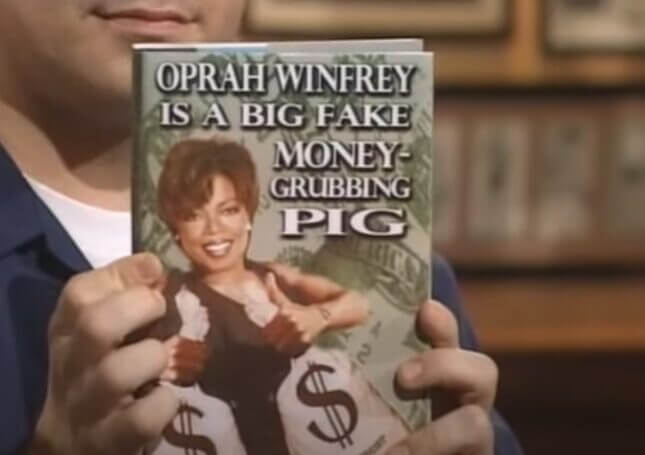How Jimmy Kimmel Went From The Man Show to Become Late Night's Woke Dad
Entertainment
Illustration: Elena Scotti (Photos: Getty Images)
“I look back at every show I’ve ever done and cringe,” Jimmy Kimmel said in 2017 of The Man Show, the early-aughts Comedy Central mainstay that he and co-host Adam Carolla starred in for nearly five years. The Man Show reveled in over-the-top sexism, running segments featuring strangers signing petitions to “end women’s suffrage” and sketches about programming subservient women at “wife school” to a roaring audience, even going so far as to make women jumping on trampolines a centerpiece of its programming.
“My vision of hell is a bunch of monitors with my old shows running on them,” Kimmel told Vulture.
Now Kimmel has gotten a sense of what hell might feel like after blackface impersonations he did of celebrities like Oprah Winfrey and Karl Malone on The Man Show resurfaced in June. “I have long been reluctant to address this,” Kimmel began his apology in a statement obtained by CNN on Tuesday. But rather than focus on the racism of his sketches, referring to makeup artists tasked with making him “look as much like Karl Malone as possible,” Kimmel seems to focus on how these past sketches have been weaponized to specifically hurt his recently built brand of a progressive-leaning television host. “Looking back, many of these sketches are embarrassing, and it is frustrating that these thoughtless moments have become a weapon used by some to diminish my criticisms of social and other injustices,” he said.
“I love this country too much to allow that,” he continued. “I won’t be bullied into silence by those who feign outrage to advance their oppressive and genuinely racist agendas.”
For Kimmel, his blackface impersonations and the frat boy degradation that made The Man Show a hit are just an embarrassing aspect of his past, a blip of immaturity in a career that has since been reformed by his show Jimmy Kimmel Live! and gigs like hosting the Oscars. In recent years, Kimmel has been outspoken about healthcare reform in America and has called out President Trump on his late-night show. But The Man Show—both its racism and sexism—laid the foundation for his current, high profile success. It’s also the reason why viewers, comforted by the reassuring political centrism of late-night television, continue to consider Kimmel an authority.
Kimmel officially broke into television in the late 1990s as the host for Win Ben Stein’s Money, the only game-show on Comedy Central in 1999, after previously working in radio as a sports reporter for Los Angeles’s KROQ. On the show, contestants played against the droll conservative speechwriter turned actor, Ben Stein, answering general trivia questions to win a portion of Stein’s paycheck. And while Kimmel wasn’t the star of the show—Stein was center stage, antagonizing contestants and answering questions—he honed his early comic voice as a TV host. “Did some kind of homo bomb explode backstage?” he asked one episode, remarking on how multiple contestants in one episode were gay.
Win Ben Stein’s Money was a success for Comedy Central, winning six Daytime Emmy awards, and the network continued to bank on Kimmel as a starring host. In 1999, the network debuted the Kimmel-created Man Show, billed as a guy’s program for guys, like a talk show with Hooters-like branding. Beer flowed freely, and women, known as “The Juggy Dance Squad,” ran through the audience, pausing for careful close-ups of their breasts. In their rolling on the street segment, the show sent out its “Man Show Boy,” an actual child, to ask grown women on the street if they’d have sex with him. Meanwhile, Carolla and Kimmel described the show as a truth-speaking “dam to hold back the feminization that is flooding this country” and a “dam to stop the river of estrogen that is drowning us in political correctness.”

Fighting the good fight against political correctness, the show continually criticized Oprah for “brainwashing” women, calling her a “money-grubbing pig.” And Kimmel complained about his now ex-wife Gina frequently. “Is it so much to ask for you to churn a little butter every once in a while?” he says one episode. “Just a few areas I’d like you to look at, jiggle butt, nothing major, we’ll get them taken care of.” Later, Kimmel goes through his wife’s bathroom cabinets to find out what takes her so long to get ready and points to a loofah. “This is supposed to get cellulite off your ass and thighs,” he notes.
-

-

-

-

-

-

-

-

-

-

-

-

-

-

-

-

-

-

-

-

-

-

-

-

-

-

-

-

-

-

-

-

-

-

-

-

-

-

-

-








































